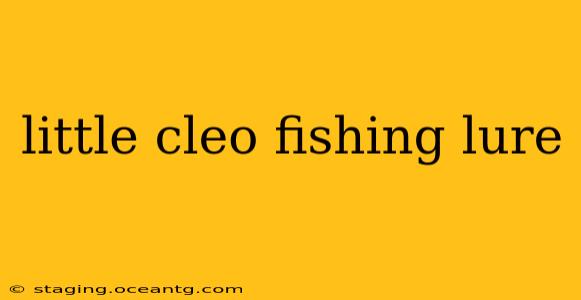The Little Cleo fishing lure has earned its place as a legend in the angling world. Its unique design and consistent effectiveness have made it a favorite among anglers targeting a variety of species, from trout and salmon to walleye and bass. But what makes this lure so special? Let's delve into the details of this iconic fishing tool, exploring its history, design features, effective fishing techniques, and answering some frequently asked questions.
What Makes the Little Cleo So Effective?
The Little Cleo's success stems from its ingenious design. Its unique shape and weight distribution create a distinctive wobble and flash underwater, mimicking the erratic movements of injured baitfish. This action triggers aggressive strikes from predatory fish. The spoon's curved profile also allows it to be cast a considerable distance, covering more water and increasing your chances of finding feeding fish.
What Types of Fish Can You Catch with a Little Cleo?
The versatility of the Little Cleo is remarkable. It's a highly effective lure for a wide range of species, including:
- Trout: Especially effective for rainbow trout and brown trout in rivers and lakes.
- Salmon: A popular choice for both landlocked and ocean-run salmon.
- Walleye: The Little Cleo's flash and wobble attract walleye, particularly in deeper, clearer water.
- Bass: Largemouth and smallmouth bass often fall prey to the Little Cleo's enticing action.
- Northern Pike: The lure's size and action make it an attractive option for this aggressive predator.
How Do You Fish a Little Cleo Effectively?
The best way to fish a Little Cleo depends on the target species and water conditions. However, some general techniques consistently yield good results:
- Casting: Cast the lure out as far as possible.
- Retrieving: A slow, steady retrieve often works best, allowing the lure's action to fully develop. Experiment with varying the speed and cadence of your retrieve to find what works best in specific conditions.
- Trolling: Trolling with a Little Cleo is another highly effective method, particularly when targeting salmon or trout in lakes or rivers. Vary your trolling speed to find the optimal speed for the fish you're targeting.
- Jigging: In deeper water, jigging the lure can entice strikes from fish holding below the surface.
What Size and Color Little Cleo Should I Use?
The optimal size and color of your Little Cleo will depend on several factors, including the target species, water clarity, and time of year. Generally:
- Size: Smaller sizes are better for smaller fish, while larger sizes are more effective for larger predators.
- Color: Bright colors are more visible in murky water, while more subdued colors work better in clearer water. Experiment with different colors to see what works best in your area.
What is the difference between a Little Cleo and other spoons?
While many spoons share similar designs, the Little Cleo distinguishes itself through its unique curve, weight distribution, and the resulting wobble and flash it produces. Other spoons might offer a different action, making them more or less effective depending on the specific fishing conditions and target species.
Where can I buy Little Cleo fishing lures?
Little Cleo lures are widely available at most sporting goods stores and online retailers that specialize in fishing gear.
Are Little Cleos good for beginners?
Yes, Little Cleos are relatively easy to use and effective for beginners. Their simple design and consistent action make them a good choice for anglers of all skill levels.
Conclusion
The Little Cleo fishing lure's enduring popularity is a testament to its effectiveness and versatility. Its unique design, combined with proper fishing techniques, makes it a powerful tool in any angler's arsenal. By understanding the lure's characteristics and experimenting with different techniques, you can significantly improve your chances of landing a variety of fish species. Remember to always check local fishing regulations before heading out.
